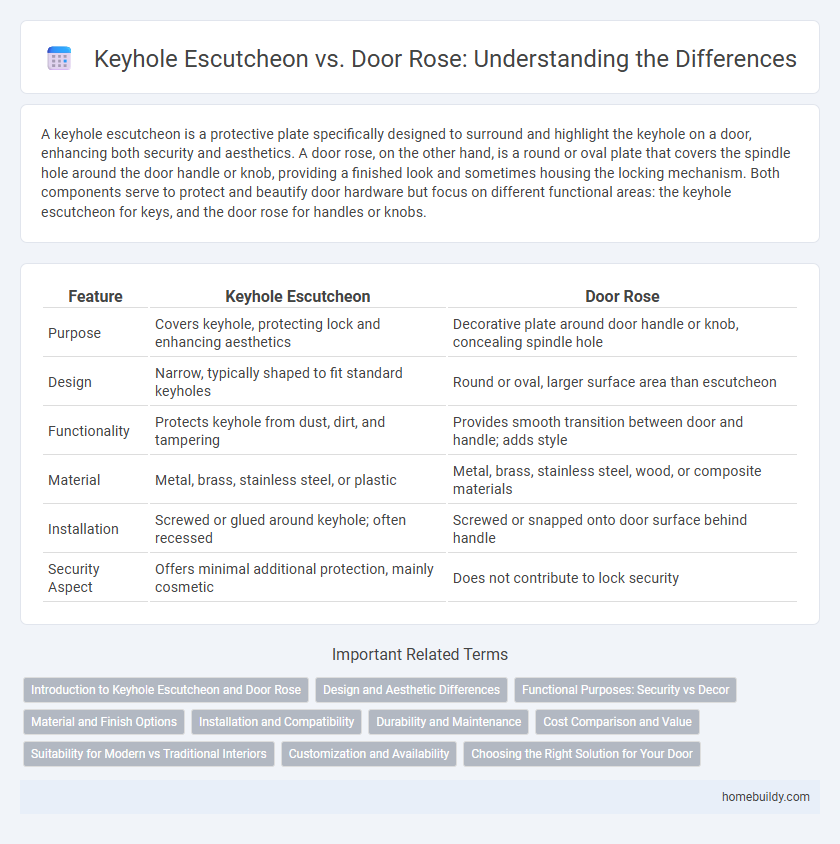A keyhole escutcheon is a protective plate specifically designed to surround and highlight the keyhole on a door, enhancing both security and aesthetics. A door rose, on the other hand, is a round or oval plate that covers the spindle hole around the door handle or knob, providing a finished look and sometimes housing the locking mechanism. Both components serve to protect and beautify door hardware but focus on different functional areas: the keyhole escutcheon for keys, and the door rose for handles or knobs.
Table of Comparison
| Feature | Keyhole Escutcheon | Door Rose |
|---|---|---|
| Purpose | Covers keyhole, protecting lock and enhancing aesthetics | Decorative plate around door handle or knob, concealing spindle hole |
| Design | Narrow, typically shaped to fit standard keyholes | Round or oval, larger surface area than escutcheon |
| Functionality | Protects keyhole from dust, dirt, and tampering | Provides smooth transition between door and handle; adds style |
| Material | Metal, brass, stainless steel, or plastic | Metal, brass, stainless steel, wood, or composite materials |
| Installation | Screwed or glued around keyhole; often recessed | Screwed or snapped onto door surface behind handle |
| Security Aspect | Offers minimal additional protection, mainly cosmetic | Does not contribute to lock security |
Introduction to Keyhole Escutcheon and Door Rose
A keyhole escutcheon is a protective plate surrounding a keyhole, designed to prevent wear and enhance the decorative appeal of doors. Door roses typically serve as the mounting plate for door handles or knobs, offering a clean finish around the spindle hole and contributing to the door's overall aesthetic. Both keyhole escutcheons and door roses are essential hardware elements that combine functionality with style in door design.
Design and Aesthetic Differences
Keyhole escutcheons provide a minimalist design, highlighting the keyhole shape with slim, unobtrusive profiles that emphasize functionality and clean lines. Door roses are typically more elaborate, featuring decorative plates that surround the door handle and keyhole, contributing to a classic or ornamental aesthetic. The choice between a keyhole escutcheon and a door rose significantly impacts the door hardware's visual appeal, where escutcheons offer subtle elegance and door roses provide a more pronounced decorative element.
Functional Purposes: Security vs Decor
Keyhole escutcheons prioritize security by covering the keyhole to protect locks from tampering and dirt, enhancing the door's overall defense. Door roses focus on decorative appeal, often serving as ornamental plates around door knobs or handles to improve aesthetic value. While both can combine style and function, keyhole escutcheons primarily ensure lock integrity, whereas door roses emphasize enhancing door design.
Material and Finish Options
Keyhole escutcheons typically feature sturdy materials such as brass, stainless steel, or aluminum, offering a variety of finishes including polished, satin, and antique to match diverse door aesthetics. Door roses are often made from similar metals but provide more extensive design and finish options like matte, brushed, or lacquered surfaces for enhanced decorative appeal. Material durability and finish versatility play crucial roles in selecting between a keyhole escutcheon and a door rose for both functional security and style consistency.
Installation and Compatibility
Keyhole escutcheons are specifically designed to fit around traditional keyholes, providing a slim profile that aligns directly with the lock mechanism, making installation straightforward in doors with a standard mortised lock. Door roses offer a larger, circular plate that often covers a broader area around the door handle or knob base, ideal for knobs without keyholes or cylinder locks, requiring compatibility with different spindle and lock types. When choosing between the two, keyhole escutcheons are typically more compatible with vintage or classic door designs, while door roses suit modern handles, necessitating careful measurement for secure installation.
Durability and Maintenance
Keyhole escutcheons are typically made from hardened metals that offer superior durability compared to door roses, which are often crafted from softer materials like brass or zinc alloys. The robust construction of keyhole escutcheons reduces wear and tear, minimizing the need for frequent repairs or replacements. Maintenance of keyhole escutcheons is generally straightforward, requiring only occasional cleaning to preserve their corrosion resistance and appearance.
Cost Comparison and Value
Keyhole escutcheons generally cost less than door roses, making them a budget-friendly choice for door hardware. Despite the lower price, keyhole escutcheons provide essential protection around keyholes and enhance door aesthetics efficiently. Door roses offer more decorative appeal and additional features, often justifying their higher price for premium or stylistic applications.
Suitability for Modern vs Traditional Interiors
Keyhole escutcheons offer a sleek, minimalist design that complements modern interiors with clean lines and contemporary hardware, enhancing the overall aesthetic of minimalist and industrial styles. Door roses, featuring more ornate and rounded shapes, are better suited for traditional interiors, providing a classic, vintage feel that matches period details and historic decor. Choosing between a keyhole escutcheon and a door rose depends on the desired architectural style, with escutcheons favoring modernity and door roses preserving traditional elegance.
Customization and Availability
Keyhole escutcheons offer extensive customization options with various shapes, sizes, and finishes tailored to specific keyholes, enhancing both functionality and aesthetic appeal. Door roses provide a more standardized design primarily focused on concealing the lock cylinder and supporting the door handle, limiting customization possibilities. Availability of keyhole escutcheons spans a broader range of styles and materials to fit diverse locksmith and architectural needs, whereas door roses are commonly found in fewer variations suited for standard door hardware configurations.
Choosing the Right Solution for Your Door
Choosing the right solution for your door often involves selecting between a keyhole escutcheon and a door rose, each offering unique functional and aesthetic benefits. A keyhole escutcheon provides precise protection and decoration specifically around keyholes, enhancing security while maintaining a classic look. Door roses cover a larger area around the handle, often complementing modern hardware designs and offering extra protection against wear and tear on the door surface.
Keyhole escutcheon vs Door rose Infographic

 homebuildy.com
homebuildy.com